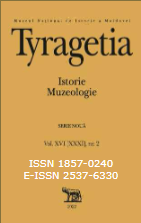Folosirea pârghiilor economice în lupta cu religia în timpul campaniei antireligioase hrușcioviste (1957-1964)
The use of economic measures in the fight against religion during the Khrushchev anti-religious campaign (1957-1964)
Author(s): Nicolae FușteiSubject(s): National Economy, Economic history, Political history, Social history, Post-War period (1950 - 1989), Socio-Economic Research
Published by: Muzeul Naţional de Istorie a Moldovei
Keywords: religion; state; salaries; pensions; religious associations;
Summary/Abstract: With the beginning of the Khrushchev’s anti-religious campaign, the state bodies took a number of measures to worsen the situation of church employees. In 1958, representatives of the Council for the Affairs of the Russian Orthodox Church were warned of special attention to clergy. In January 1959, a closed meeting of the party organization of the Council for the Affairs of the Russian Orthodox Church and a meeting of the representatives of the Council took place, at which the Council and its chairman G.G. Karpov were sharply criticized. Karpov was accused of “peaceful attitude to the activation of the clergy, unscrupulousness in relations with the clergy”. The Council for the Affairs of the Russian Orthodox Church was accused of condoning the fact that the staff of churches has increased to tens of thousands of people who are not engaged in socially useful work, but enjoy all the benefits and guarantees provided for workers and employees of state enterprises. Some of the commissioners, opposed to the church, asked the Council for Church Affairs to take measures to change Soviet legislation on social guarantees provided to church ministers. These interventions had an effect. The ideological department of the Central Committee of the CPSU addressed the Council for the Affairs of the Russian Orthodox Church with a proposal “if possible, as soon as possible, to reduce the number of church servants [...] to stop state social insurance of civilian personnel among church servants, to abolish trade union organizations within religious associations...”. In 1961, two resolutions of the Central Committee of the CPSU and the Council of Ministers of the USSR were developed, which worsened the financial situation of church employees: “On the elimination of distortions in the calculation of pensions for workers and employees of religious organizations” and “On increasing the tax on ministers of religious cults, church choirs, regents, organists and teachers of religious educational institutions”. In 1962, the fight against church officials continued with the resolution of the Central Committee of the CPSU “On limiting the circle of persons working in religious organizations covered by labor legislation”. The Central Committee of the CPSU sharply criticized the trade unions for providing “illegal privileges and benefits” to workers of religious organizations, which forced the All-Union Central Council of Trade Unions to make a number of cardinal decisions. The Commission on Current Affairs under the Presidium of the Council of Ministers of the USSR of June 3 and the Presidium of the Central Committee of Trade Unions of Local Workers and Public Utilities of August 21, 1962 revised the categories of persons employed in religious organizations who were under the protection of trade unions. The document provided for new rules for membership in trade unions of workers of religious organizations. Labor law now applied to a small number of low-paid church employees: janitors, guards, porters, and stokers. Special instructions from the State Committee for Labor and Wages under the All-Union Central Council of Trade Unions on the establishment of pensions for workers and officials of religious associations were sent to all authorized representatives of the Council. As a result of the measures taken, there has been a decrease in the number of employees in religious communities throughout the country
Journal: Tyragetia (Serie Nouă)
- Issue Year: XVI/2022
- Issue No: 2
- Page Range: 209-220
- Page Count: 12
- Language: Romanian

